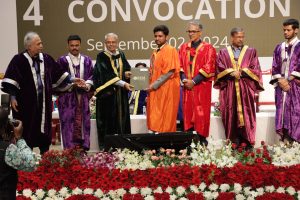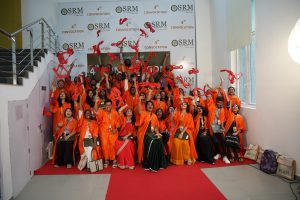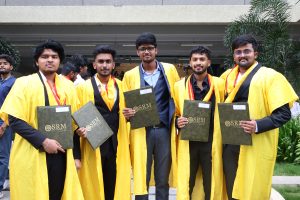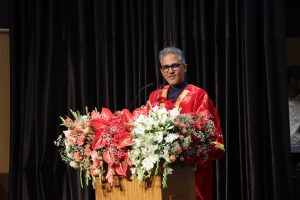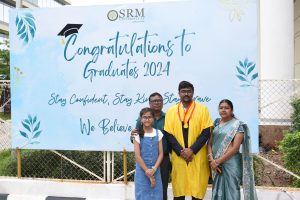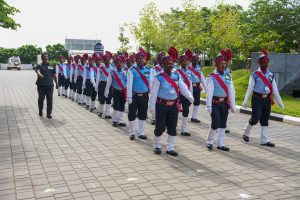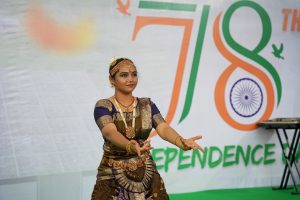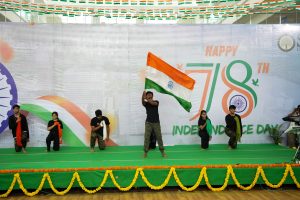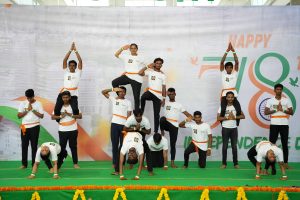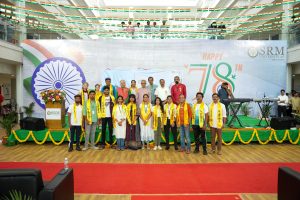“A New Array of Leaders Graduate Today” – SRM AP Hosted its 4th Convocation Ceremony
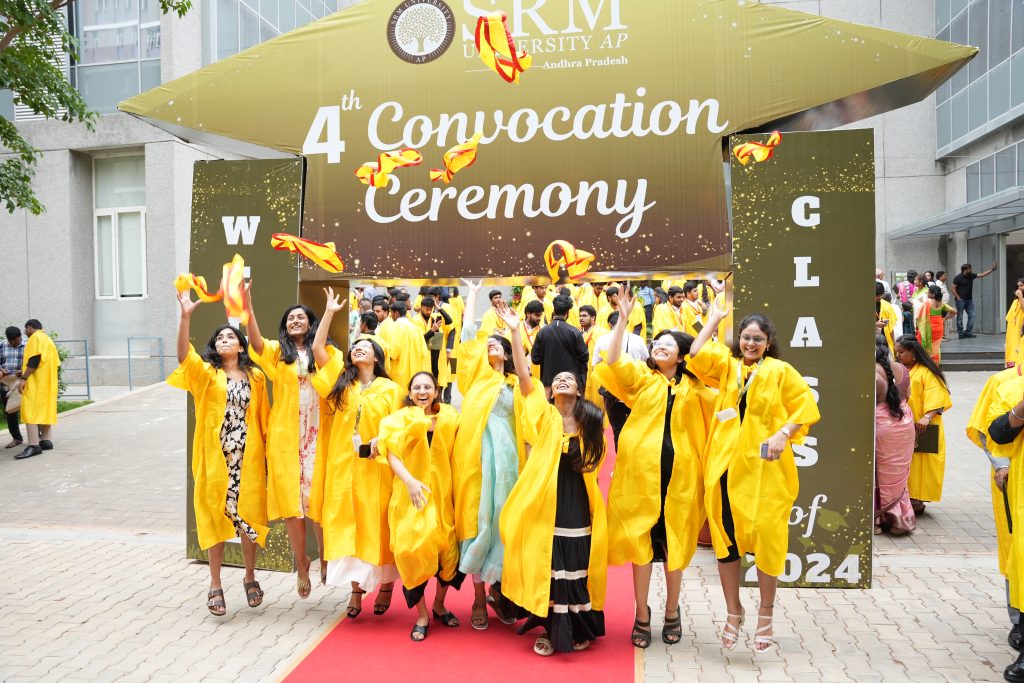
SRM University-AP hosted its prestigious 4th Convocation Ceremony on September 02, 2024, felicitating the graduates with their well-earned degrees for scholastic excellence. The monumental event was graced by the honourable presence of Chief Guest Padma Bhushan Senapathy Kris Gopalakrishnan, Chairman-Axilor Ventures and Co-founder of Infosys; Guest of Honour Mr Rohit Kapoor, Chief Executive Officer, Food Marketplace, Swiggy; Founder Chancellor of SRM Group of Institutions Dr T R Paarivendhar; Pro-Chancellor of SRM University-AP Dr P Sathyanarayanan; Vice Chancellor Prof. Manoj K Arora, Other dignitaries, Faculty, staff and parents of the graduating batch. 1,018 graduates, including 24 PhD scholars, were conferred their degrees on this momentous occasion, and 18 Gold Medalists, 5 Silver Medalists, and 5 Bronze Medalists were recognised for their outstanding achievements.
“We are a multidisciplinary research-intensive university where education revolves around 5 I’s – Integrative curricula, Interdisciplinary Research and Learning, Innovation, Industry and International Collaborations and Inclusivity”, stated Vice Chancellor, Prof. Manoj K Arora, in his welcome address. Prof. Arora also gave a brief about the annual report, highlighting the university’s stellar growth and accomplishments in the past academic year.
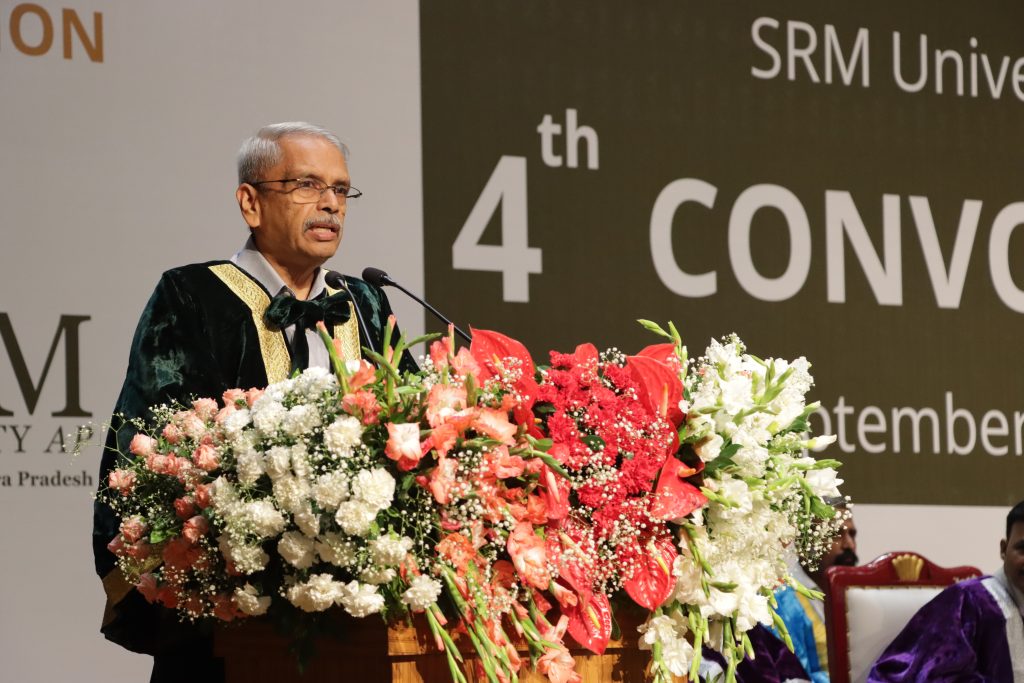
Chief Guest Padma Bhushan Kris Gopalakrishnan, renowned global business & technology thought leader, delivered the much-anticipated convocation address to the graduating Class of 2024. With an analogy to the Paris Olympics 2024, Mr Kris Gopalakrishnan ignited the graduating batch with key takeaways to ensure remarkable success in all their future endeavours. He stated, “The knowledge and skillset that you have acquired from your university will equip you to face the problems that the world poses. The strength of the university lies with the alumni. Remember to contribute to the society, your nation and moreover your alma mater.”
Mr Rohit Kapoor, the esteemed Guest of Honour, applauded the students for their outstanding achievements and expressed his deep respect for SRM University-AP for establishing a new-age institute and preparing the students for an impactful future. “We must strive towards world-class standards in the case of academics, research, and innovation and deriving nobility in becoming the superior version of yourselves”, advised Mr Kapoor.
The ceremony also witnessed the auspicious presence of Founder Chancellor Dr T R Paarivendhar, who congratulated the young students for this remarkable achievement and advised, “Knowledge is power. Enhance your knowledge by keeping abreast of upcoming technology and the exponential growth due to the digital revolution. You must be bold in life, content in life to be the best citizen of this country.” Pro-Chancellor Dr P Sathyanarayanan offered his heartfelt praises to the Class of 2024, stating, “With the vision to be a world-class university that dominates national and international frontiers, we emphasise the importance of premier education. While you transition from the phase of learning to earning, bear in mind that learning is always a thread of the fabric of your life.”
The convocation ceremony successfully concluded with the administration of the pledge by the graduation cohort, honouring the national anthem and the departure of the dignitaries.
- Published in News
Dr Mahesh Kumar Secures Patent for Advanced Data Generation Method
 In a significant achievement for the Department of Computer Science and Engineering, Dr Mahesh Kumar Morampudi, Assistant Professor, along with B.Tech. student Ms. Nunna Lakshmi Manasa, has been granted a patent for their groundbreaking invention titled “System and method for generating synthetic data based on variational autoencoder.” The patent, with Application Number: 202241049545, was officially recognised in the Indian Patent Office.
In a significant achievement for the Department of Computer Science and Engineering, Dr Mahesh Kumar Morampudi, Assistant Professor, along with B.Tech. student Ms. Nunna Lakshmi Manasa, has been granted a patent for their groundbreaking invention titled “System and method for generating synthetic data based on variational autoencoder.” The patent, with Application Number: 202241049545, was officially recognised in the Indian Patent Office.
This innovative system leverages the capabilities of variational autoencoders to generate synthetic data, which has vast applications in various fields, including machine learning, data privacy, and simulation. The ability to create high-quality synthetic datasets can significantly enhance research and development processes, providing researchers and practitioners with valuable tools for analysis and experimentation.
The recognition of this patent not only highlights the innovative spirit within the department but also underscores the collaborative efforts between faculty and students in advancing technology and contributing to the field of computer science.
Abstract of the Research
Diabetic retinopathy (DR) is a diabetes-related eye condition that occurs when high blood sugar levels cause damage to the blood vessels in the retina, the light-sensitive tissue at the back of the eye. Over time, these damaged vessels can leak blood or other fluids, leading to vision impairment.
DR typically progresses through stages, starting with mild non-proliferative retinopathy, where small bulges form in the blood vessels, to proliferative retinopathy, the most severe stage, where new abnormal blood vessels grow on the retina and in the vitreous humor, potentially leading to blindness. Early detection and management are crucial to prevent significant vision loss, often involving regular eye exams, blood sugar control, and treatments like laser therapy or surgery.
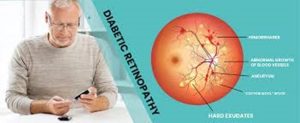
Synthetic data generation for DR is an emerging approach to augment limited clinical datasets, enhancing the training of machine learning models for diagnosis and prognosis. The present disclosure envisages a system for generating synthetic data based on a variational autoencoder (VAE). This work explores the use of a VAE combined with deep learning for the detection and classification of DR. VAEs, known for their ability to learn compact and meaningful representations of complex data, are employed to generate latent features from retinal images, effectively capturing the subtle variations and anomalies indicative of DR. These latent features are then fed into a deep learning classifier, which is trained to categorise the severity of DR into various stages, ranging from no DR to proliferative DR.
Research in Layperson’s Terms
Imagine your eye is like a camera, and the retina at the back of your eye is the film that captures the pictures you see. DR is a condition that affects this “film” when someone has diabetes for a long time. High blood sugar levels can damage the tiny blood vessels in the retina, leading to vision problems and, in severe cases, blindness.
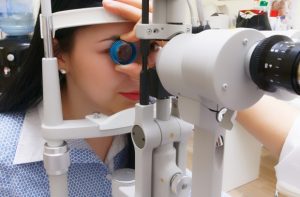
Our research is about creating a computer program that can help doctors detect and classify this eye condition more accurately. We use a special kind of technology called a VAE, which is like a smart artist that learns to understand and recreate detailed images of the retina. This “artist” can pick up on the tiny changes and patterns in the retina that might be missed by the human eye. Once the VAE has learned these details, it passes them on to another program, which is really good at sorting things into categories. This second program, a deep learning classifier, uses the information from the VAE to decide how severe diabetic retinopathy is—whether it’s mild, moderate, or severe.
By combining these two technologies, our system can help doctors detect diabetic retinopathy earlier and more accurately, which is crucial for preventing vision loss in people with diabetes.
Title of the Patent in the Citation Format
Inventor Name(s):
Dr Mahesh Kumar Morampudi
Nunna Lakshmi Manasa
“System and method for generating synthetic data based on variational auto encoder” with Application Number: ” 202241049545.” Date of Patent Grant. 29/07/2024
Practical Implementation:
The practical implementation of our research involves integrating the VAE and deep learning classifier into a software tool that can be used by eye care professionals. Here’s how it might work in a real-world setting:
- Data Collection: Retinal images are collected from patients during routine eye exams. These images are fed into the system, which has been trained using a large dataset of retinal images, including those showing different stages of DR.
- Feature Extraction: The VAE processes these images, learning to capture and condense the important features that indicate the presence and severity of DR. This step is crucial because it allows the system to focus on the subtle details that might signify early stages of the disease.
- Classification: The deep learning classifier then takes these features and classifies the severity of DR. It provides a diagnosis, categorising the condition as no DR, mild, moderate, or severe. The system could also flag cases that need urgent attention, helping prioritise patient care.
- Clinical Decision Support: The results are presented to the healthcare provider through an intuitive interface. This tool could be used in clinics, especially in areas with limited access to specialised eye care, allowing general practitioners or technicians to screen for DR and refer patients for further treatment if needed.
Social Implications:
- Increased Access to Early Detection: By automating the detection of diabetic retinopathy, this technology can be deployed in remote or underserved areas where access to specialists is limited. Early detection is key to preventing vision loss, and this tool can make screening more accessible, especially in communities with high rates of diabetes.
- Reduced Healthcare Costs: Early detection and treatment of diabetic retinopathy can prevent the progression to more severe stages, reducing the need for expensive treatments like surgery or long-term care for blindness. This could lower healthcare costs for both patients and the healthcare system.
- Empowering Healthcare Providers: The tool can support general healthcare providers in making more accurate diagnoses, reducing the burden on specialists and allowing them to focus on more complex cases. This democratizes eye care, making it possible for more people to get the care they need without long delays.
- Improved Patient Outcomes: With more accurate and timely diagnosis, patients can receive treatment sooner, leading to better health outcomes and preserving vision. This can significantly enhance the quality of life for individuals with diabetes, who might otherwise suffer from preventable blindness.
- Ethical Considerations: While technology offers many benefits, it also raises ethical questions about the use of AI in healthcare, such as ensuring that the system is fair, transparent, and does not introduce biases. Continuous monitoring and updates would be necessary to ensure the system remains accurate and equitable.
Future Research Plans
- Improving Model Robustness and Generalization: Enhance the VAE and deep learning classifier’s ability to generalize across diverse populations and imaging conditions.
- Incorporating Multimodal Data: Integrate additional data sources, such as patient medical history, blood sugar levels, and genetic information, to improve diagnostic accuracy.
- Real-Time Implementation and Mobile Integration: Adapt the system for real-time analysis and deploy it on mobile devices.
- Collaboration with Clinical Trials: Validate the AI system’s effectiveness through collaboration with clinical trials.
- Published in CSE NEWS, Departmental News, News, Research News
Honouring the Founder’s Legacy: Celebrating the Vision and Impact of an Inspiring Leader
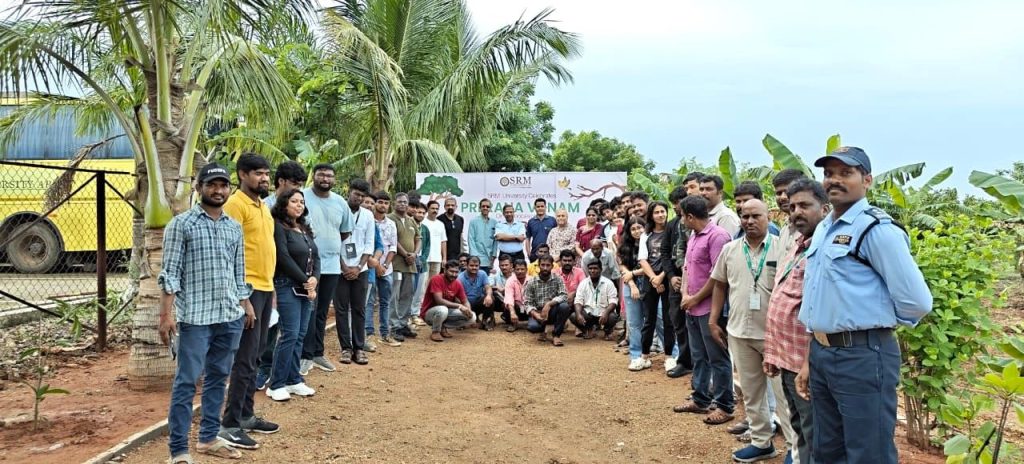 On August 24, 2024, SRM University-AP commemorated a significant event marking the 85th Birthday of the esteemed Founder Chancellor of the SRM Group, Dr T R Paarivendhar, celebrating his visionary leadership and contributions. In honour of this day, and reinforcing the ethos of sustainability and environmental consciousness, the university launched “Prerna Vanam,” a plantation-drive initiative.
On August 24, 2024, SRM University-AP commemorated a significant event marking the 85th Birthday of the esteemed Founder Chancellor of the SRM Group, Dr T R Paarivendhar, celebrating his visionary leadership and contributions. In honour of this day, and reinforcing the ethos of sustainability and environmental consciousness, the university launched “Prerna Vanam,” a plantation-drive initiative.
This annual initiative served as a testament to the varsity’s ongoing efforts to contribute positively to the environment, aligning with global sustainability goals and the founder’s visionary ideals. As we face the challenges of global warming, the varsity comes together to combat climate change, support biodiversity, and ensure a sustainable future. The event held at the university campus was attended by students, staff, and faculty members of the university and helped set a practical example of how institutions can play a pivotal role in making the world a better place for future generations by investing in ecological sustainability.
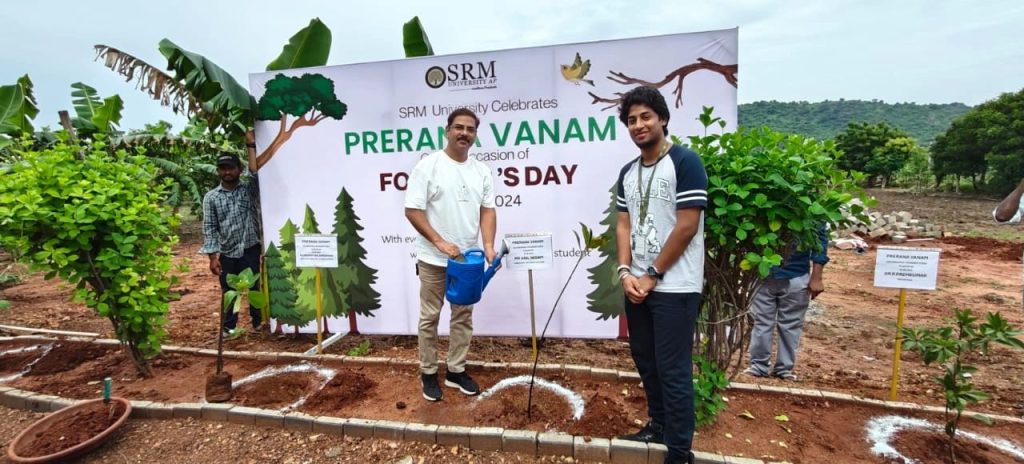
- Published in News, University Event
A Display of Victory and Freedom: 78th Independence Day Celebrations
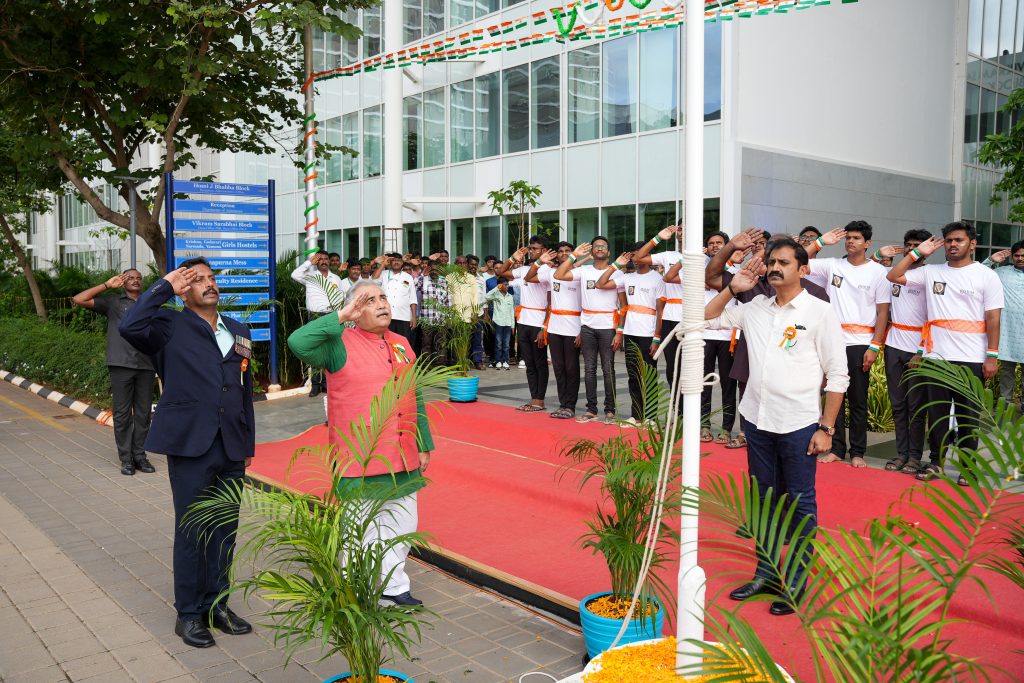
SRM University-AP signalled the commencement of the 78th Independence Day festivities filled with pride and patriotic magnificence by hoisting the national flag. Vice Chancellor Prof. Manoj K Arora did the honours by highlighting the progress made by our country in the past 77 years and the leaps that SRM University-AP has taken since its origin. He emphasised the tremendous hard work everyone has done to achieve this scale of independence and success for the country and the society.
In his speech, Prof. Arora recalled the various triumphs and advancements that India has attained till now. He addressed the different important qualities a student needs to have to succeed and further proved how these qualities are imparted in SRM University-AP through its curriculum, course plans, and innovative pedagogy. He also called attention to the support of the maintenance staff, security, housekeeping personnel, and construction workers, without whom the stellar progress of the University couldn’t have been possible.
Dr R Premkumar, Registrar, Deans of all schools, Directors, faculty, staff, and students also participated in this wonderful celebration of patriotism.
The programme also encapsulated awe-inspiring stories of the past by the Theatre Club, a stimulating dance performance by the Dance Community, mesmerising performances by the Music Club and a splendid parade organised by Campus Life Management.
- Published in News


